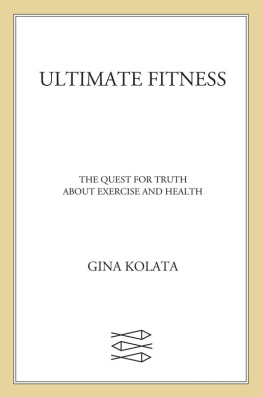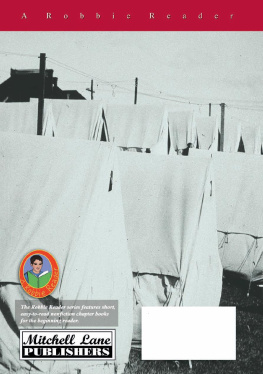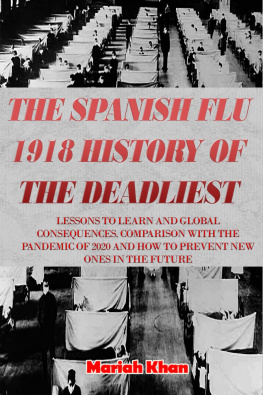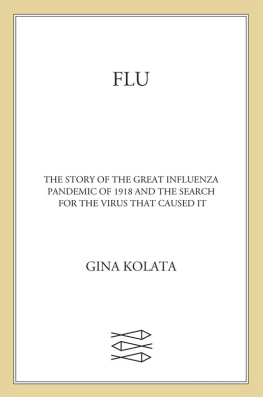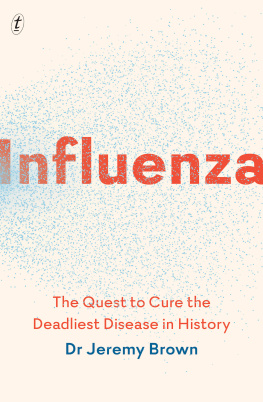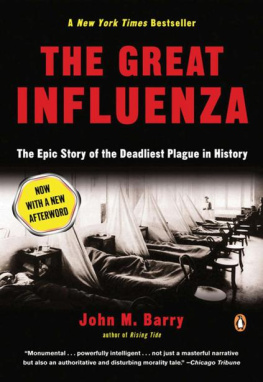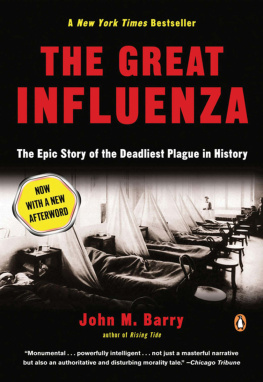If anyone should have known about the 1918 flu, it was I.
I was a microbiology major in college and even took a course in virology. But the 1918 flu was never mentioned. I also took history courses in college, with one of my favorites being a class that covered the important events of the twentieth century. But although World War I was a major part of the course, the 1918 flu was not discussed. I have written about diseases and medicine for my entire career, first at Science magazine and then at The New York Times , even writing articles about influenza. But I never paid any attention to the 1918 flu.
In retrospect, it is hard for me to understand my ignorance. The 1918 flu epidemic puts every other epidemic of this century to shame. It was a plague so deadly that if a similar virus were to strike today, it would kill more people in a single year than heart disease, cancers, strokes, chronic pulmonary disease, AIDS, and Alzheimers disease combined. The epidemic affected the course of history and was a terrifying presence at the end of World War I, killing more Americans in a single year than diedin battle in World War I, World War II, the Korean War, and the Vietnam War.
The 1918 flu even affected my family and my husbands family. My father insisted on heeding the advice of an old doctor who had lived through that flu and who decided, as a consequence, to blast every respiratory illness with erythromycin. As a child, I took the antibiotic every time I had a fever, useless though it was in fighting most common respiratory diseases. Yet I did not make the connection with the doctors frightening experience with the 1918 flu and his steadfast faith in a wonder drug discovered decades later. When I grew older and understood the overuse of antibiotics, I would disparage my fathers doctor, arguing that he was irrational.
In my husbands family, the flu had been a life-altering event. My husbands mother was a young girl when her father died of the viral infection and her mother was left to bring up four children alone. Somehow, though, neither my husband nor I quite realized what had happened. His mother had always said that her father died of pneumonia that he caught from working in a foundry.
It seems remarkable to me now that I never grasped the fact that a terrible epidemic had swept the world in 1918, leaving death and devastation in its wake and touching nearly every family with its icy hand. But, I have learned, I was not alone in my ignorance. The 1918 influenza epidemic is one of historys great conundrums, obliterated from the consciousness of historians, who traditionally ignore science and technology but not, for the most part, plagues.
My epiphany came in 1997, when I wrote an article in The New York Times about a remarkable paper being published in the journal Science. That paper, which involved the first attempts to resurrect the viruss genetic code, was also a key clue in a medical mystery story that is as astonishing as the 1918 influenza itself. It involves science and politics, at their most confused and at theirfinest. It involves a virus that is one of the worst killers ever known. And it involves researchers who became obsessed with tracking the virus down. Like all good mystery stories, it also has elements of serendipity and surprise.
It is a story that begged to be told, both for the sheer drama of the tale and for its implications. The resolution of the mystery could help scientists save humanity if that terrible virus or another one like it stalks the earth again.
THE PLAGUE YEAR
This is a detective story. Here was a mass murderer that was around 80 years ago and whos never been brought to justice. And what were trying to do is find the murderer.
Jeffery Taubenberger, molecular pathologist
When the plague came, on those chilly days of autumn, some said it was a terrible new weapon of war. The plague germs were inserted into aspirin made by the German drug company Bayer. Take an aspirin for a headache and the germs will creep through your body. Then your fate is sealed.
No, the plague came in on a camouflaged German ship that had crept into Boston Harbor under cover of darkness and released the germs that seeded the city. Boston, after all, was where the plague started. There was an eyewitness, an old woman who said she saw a greasy-looking cloud that floated over the harbor and wafted over the docks.
No, it was started by Germans who slipped into Boston Harbor on U-boats and then sneaked ashore, carrying vials of theplague germs with them. They let the germs loose in theaters and among crowds gathered for those interminable Liberty Bond rallies. Lieutenant Colonel Philip S. Doane, head of the Health Sanitation Section of the Emergency Fleet Corporation, said so, and he certainly was in a position to know. It was on page one of the Philadelphia Inquirer.
Soon the plague was everywhere. And no one was safe.
The sickness preyed on the young and healthy. One day you are fine, strong, and invulnerable. You might be busy at work in your office. Or maybe you are knitting a scarf for the brave troops fighting the war to end all wars. Or maybe you are a soldier reporting for basic training, your first time away from home and family.
You might notice a dull headache. Your eyes might start to burn. You start to shiver and you will take to your bed, curling up in a ball. But no amount of blankets can keep you warm. You fall into a restless sleep, dreaming the distorted nightmares of delirium as your fever climbs. And when you drift out of sleep, into a sort of semi-consciousness, your muscles will ache and your head will throb and you will somehow know that, step by step, as your body feebly cries out no, you are moving steadily toward death.
It may take a few days, it may take a few hours, but there is nothing that can stop the diseases progress. Doctors and nurses have learned to spot the signs. Your face turns a dark brownish purple. You start to cough up blood. Your feet turn black. Finally, as the end nears, you frantically gasp for breath. A blood-tinged saliva bubbles out of your mouth. You dieby drowning, actuallyas your lungs fill with a reddish fluid.
And when a doctor does an autopsy, he will observe your lungs lying heavy and sodden in your chest, engorged with a thin bloody liquid, useless, like slabs of liver.
They called the plague of 1918 influenza, but it was like no influenza ever seen before. It was more like a biblical prophecycome true, something from Revelations that predicted that first the world was to be struck by war, then famine, and then, with the breaking of the fourth seal of the scroll foretelling the future, the appearance of a horse, deathly pale, and its rider was called Plague, and Hades followed at its heels.
The plague took off in September of that year, and when it was over, half a million Americans would lie dead. The illness spread to the most remote parts of the globe. Some Eskimo villages were decimated, nearly eliminated from the face of the earth. Twenty percent of Western Samoans perished. And no matter where it struck, the virus went after an unusual groupyoung adults who generally are spared the ravages of infectious diseases. The death curves were W-shaped, with peaks for the babies and toddlers under age 5, the elderly who were aged 70 to 74, and people aged 20 to 40.
Children were orphaned, families destroyed. Some who lived through it said it was so horrible that they would not even talk about it. Others tried to put it behind them as another wartime nightmare, somehow conflating it with the horrors of trench warfare and mustard gas. It came when the world was weary of war. It swept the globe in months, ending when the war did. It went away as mysteriously as it appeared. And when it was over, humanity had been struck by a disease that killed more people in a few months time than any other illness in the history of the world.




